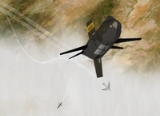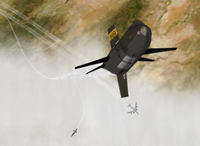
X-15 Flight 3-65-97
Encyclopedia
| Mission Illustration | |
|---|---|
 |
|
| Mission Statistics | |
| Mission Name: | X-15 Flight 3-65-97 |
| Vehicle: | X-15 56-6672 |
| Number of Crew Members: |
1 |
| Launch: | November 15, 1967 18:30:07.4 UTC Coordinated Universal Time Coordinated Universal Time is the primary time standard by which the world regulates clocks and time. It is one of several closely related successors to Greenwich Mean Time. Computer servers, online services and other entities that rely on having a universally accepted time use UTC for that purpose... NB-52B Flying near Delamar Dry Lake, NV |
| Landing: | November 15, 1967 18:34:57.5 UTC Broke up over Randsburg, CA |
| Duration: B-52 drop to X-15 break-up |
10 min 35 seconds |
| Number of Orbits: |
Suborbital |
| Apogee: | 266,000 feet |
| Distance Traveled: |
Unknown |
| Maximum velocity: |
5,745 km/h |
| Peak acceleration: | 5 G (49 m/s²) |
| Mass: | unknown kg fueled; unknown kg burnout; |
| Crew Picture | |
| Michael J. Adams | |
X-15 Flight 3-65-97, also known as X-15 Flight 191, was a test flight of the North American X-15
North American X-15
The North American X-15 rocket-powered aircraft/spaceplane was part of the X-series of experimental aircraft, initiated with the Bell X-1, that were made for the USAAF/USAF, NACA/NASA, and the USN. The X-15 set speed and altitude records in the early 1960s, reaching the edge of outer space and...
experimental aircraft
Experimental aircraft
An experimental aircraft is an aircraft that has not yet been fully proven in flight. Often, this implies that new aerospace technologies are being tested on the aircraft, though the label is more broad....
. It took place on November 15, 1967 and was piloted by Michael J. Adams. It ended in tragedy when the aircraft broke apart minutes after launch due to technical difficulties, killing the pilot and destroying the plane.
Mission parameters
- Mass: unknown kg fueled; unknown kg burnout
- Maximum Altitude: 266,000 feet (50.38 miles)
- Range: unknown
- Burn Time: 83.2 seconds
- Mach: 5.20
- Launch Vehicle: NB-52B Bomber #008Balls 8Balls 8 was a NASA Boeing NB-52B mothership. It derives its nickname from its NASA tail number 52-008: leading zeroes plus the number 8. Among USAF personnel it is common practice to refer to aircraft whose tail number is a single number preceded by multiple zeros as "Balls" and the last number of...
Mission overview
Adams' seventh X-15 flight took place on November 15, 1967 in the number three aircraft. At 10:30 in the morning on November 15, the X-15-3 dropped away from underneath the wing of NB-52BBalls 8
Balls 8 was a NASA Boeing NB-52B mothership. It derives its nickname from its NASA tail number 52-008: leading zeroes plus the number 8. Among USAF personnel it is common practice to refer to aircraft whose tail number is a single number preceded by multiple zeros as "Balls" and the last number of...
at 45,000 feet over Delamar Dry Lake.
While in powered flight, an electrical disturbance distracted Adams and slightly degraded the control of the aircraft; having adequate backup controls, Adams continued on. At 10:33 he reached a peak altitude of 266,000 feet. In the NASA 1 control room, mission controller Pete Knight
William J. Knight
William J. "Pete" Knight was a U.S. politician, combat pilot, test pilot, and astronaut. Knight holds the world's speed record for flight in a winged, powered aircraft...
monitored the mission with a team of engineer
Engineer
An engineer is a professional practitioner of engineering, concerned with applying scientific knowledge, mathematics and ingenuity to develop solutions for technical problems. Engineers design materials, structures, machines and systems while considering the limitations imposed by practicality,...
s.
As the X-15 climbed, Adams began a planned wing-rocking (rolling)
Flight dynamics
Flight dynamics is the science of air vehicle orientation and control in three dimensions. The three critical flight dynamics parameters are the angles of rotation in three dimensions about the vehicle's center of mass, known as pitch, roll and yaw .Aerospace engineers develop control systems for...
maneuver so an on-board camera could scan the horizon. At the conclusion of the wing-rocking portion of the climb, the X-15 had begun a slow drift in heading; 40 seconds later, when the aircraft had reached its maximum altitude
Altitude
Altitude or height is defined based on the context in which it is used . As a general definition, altitude is a distance measurement, usually in the vertical or "up" direction, between a reference datum and a point or object. The reference datum also often varies according to the context...
, it was off heading by 15 degrees to the left. As Adams came over the top, the drift briefly halted as the aircraft's nose yawed 15 degrees back to the correct attitude. Then the drift to the left began again; within 30 seconds, Adams' descending flight path was at right angles to the attitude of the aircraft. At 230,000 feet, while descending into the rapidly increasing density of the atmosphere, the X-15 entered a Mach 5
Mach number
Mach number is the speed of an object moving through air, or any other fluid substance, divided by the speed of sound as it is in that substance for its particular physical conditions, including those of temperature and pressure...
spin.
In the NASA 1 control room there was no way to monitor the heading of the aircraft, so the situation was unknown to the engineers monitoring the flight. Normal conversation continued between Knight and Adams, with Knight advising Adams that he was "a little bit high," but in "real good shape." Adams radioed that the aircraft "[seemed] squirrelly," and moments later repeatedly told Knight that he had entered a spin. The ground controllers sought to get the X-15 straightened out, but there was no recommended spin recovery technique for the X-15, and engineers knew nothing about the aircraft's supersonic spin tendencies. The chase pilots, realizing that the X-15 would never make Rogers Dry Lake, headed for the emergency lakes; Ballarat and Cuddeback, in case Adams attempted an emergency landing.
Adams held the X-15's controls against the spin, using both the flight controls and the reaction control jets in the nose and wings. He managed to recover from the spin at 118,000 feet and went into an inverted Mach 4.7 dive at an angle between 40 and 45 degrees. In theory, Adams was in a good position to roll upright, pull out of the dive and set up a landing. However, due to high gain in the adaptive control system, the X-15 went into pilot induced oscillation with rapid pitching motion of increasing severity, still in a dive at 160,000 feet per minute. As the X-15 neared 65,000 feet, it was diving at Mach 3.93 and experiencing more than 15g
G-force
The g-force associated with an object is its acceleration relative to free-fall. This acceleration experienced by an object is due to the vector sum of non-gravitational forces acting on an object free to move. The accelerations that are not produced by gravity are termed proper accelerations, and...
vertically, and 8g laterally.
The aircraft broke up northeast of the town of Johannesburg 10 minutes and 35 seconds after launch. An Air Force pilot, who was filling in for another chase pilot, spotted the main wreckage northwest of Cuddeback Lake. The aircraft was destroyed, and Adams was killed.
Investigation
NASA and the Air Force convened an accident board. Chaired by NASA's Donald R. Bellman, the board took two months to prepare its report. Ground parties scoured the countryside looking for wreckage, specifically the film from the cockpit camera. The weekend after the accident, an unofficial FRC(NASA Dryden Flight Research Center) search party found the camera, but could not find the film cartridge. FRC engineer Victor W. Horton organized a search and on November 29, during the first pass over the area, Willard E. Dives found the cassette.The accident board found that the cockpit instrumentation had been functioning properly, and concluded that Adams had lost control of the X-15 as a result of a combination of distraction, misinterpretation of his instrumentation display, and possible vertigo
Vertigo (medical)
Vertigo is a type of dizziness, where there is a feeling of motion when one is stationary. The symptoms are due to a dysfunction of the vestibular system in the inner ear...
. The electrical disturbance early in the flight degraded the overall effectiveness of the aircraft's control system and further added to pilot workload.
The board made two major recommendations: install a telemetered heading indicator in the control room, visible to the flight controller; and medically screen X-15 pilot candidates for labyrinth (vertigo) sensitivity. As a result of the X-15's crash, the FRC added a ground-based "8 ball" attitude indicator
Attitude indicator
An attitude indicator , also known as gyro horizon or artificial horizon, is an instrument used in an aircraft to inform the pilot of the orientation of the aircraft relative to earth. It indicates pitch and bank or roll and is a primary instrument for flight in instrument meteorological conditions...
(Horton's idea) in the control room to furnish mission controllers with real time pitch, roll, yaw, heading, angle of attack, and sideslip information.
| 2nd 100 km Flight: X-15 Flight 91 X-15 Flight 91 X-15 Flight 91 was a 1963 American human spaceflight mission, and the second and final flight in the program to achieve sub-orbital spaceflight: a flight over 100km in altitude. It was the first flight of a reused spacecraft, as plane number three flew the previous sub-orbital flight on July 19.... |
X-15 Program | End of X-15 Program: X-15 Flight 199 |

